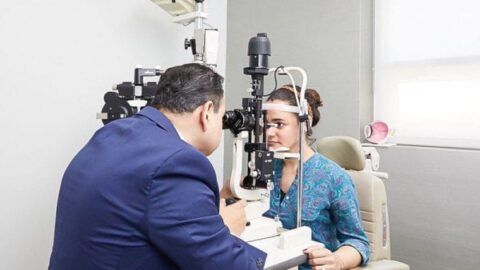This guide explains the procedure for installing dental implants. For more information about dental implant prices or finding a clinic overseas offering dental implant surgery, see our Ultimate Guide to Dental Implants.
Contents
- Before the procedure
- Anesthetic
- Preparing the implant site
- Drilling the pilot hole
- Finishing the hole
- Placing the implant
- Healing and osseointegration
- Permanent restoration
- After the procedure
Before the Procedure
Dental implants require a strong jaw bone. Patients who have lost a lot of jawbone may need to have a bone graft procedure performed before this procedure. Your implantologist (the dentist, oral surgeon, or other dental professional performing the surgery) will tell you if this is necessary. This procedure is performed after the bone graft has healed, if necessary, and any damaged tooth has been extracted.
You will receive instructions from the clinic about how to prepare for the day of the procedure. It is highly recommended you quit smoking several months before the procedure as smoking can cause poor osseointegration (poor bone and implant integration), which is the leading cause of implant failure.
Anesthetic
The procedure starts with a local anesthetic. This will make the implant site and the area around it completely numb. You will be awake, but you won’t be able to feel any pain in that area. You might still feel pressure, vibrations, or some other sensations that might be uncomfortable, but no pain. Some clinics offer conscious sedation or partial sedation where you are awake and numb, but “out of it” and mostly unaware of what is going on. Some people describe the feeling as similar to being drunk. Partial sedation is usually more expensive than local anesthetic and is not available at every clinic.
Preparing the Implant Site
After the anesthetic has taken effect, the implant site will be prepared and the gums will be opened so the dentist can access the jawbone and evaluate the implant site. The bone needs to be relatively flat and smooth, and the dentist might use a drill to reshape it.
Drilling the Pilot Hole

If no adjustments are needed, the pilot hole will be drilled deeper. As the hole is being created, the dentist may flush the area with water or saline to keep the bone cool and prevent overheating caused by drilling. Once the pilot hole is finished they will check its alignment again using the alignment pin. If the positioning of the implant is close to other anatomical structures, such as nerves or blood vessels, they may take an x-ray with the alignment pin in place to check its position.
Finishing the Hole
When the pilot hole is finished, the dentist will use a series of increasingly larger drill bits until it’s the correct diameter for the implant. The size of the implant will have been chosen ahead of time based on the condition of the bone. Usually, your dentist will want to select the largest implant that your bone can sustain because larger implants distribute their load to the bone better than smaller implants do. Most are about 4 mm in diameter.
After the hole for the implant is finished, the alignment will be checked again using the pin. Then the whole will be threaded using a screw tap to match the threads on the implant. Some implants are self-tapping and don’t require this step.
Placing the Implant
Finally, the implant will be placed. This can be done using a special head for the dental drill or using a small hand wrench. Sometimes it is actually done using a small torque wrench. This can cause some unpleasant sensations but skilled surgeons are able to minimize the discomfort. The surgical site will be closed using an implant cap and stitches.
Healing and Osseointegration
The stitches will be left in place for 7 to 10 days, after which they will be removed. In some cases, the gum flaps may be stitched so that they cover the implant cap as the site heals and the gum tissue will later be trimmed back when the abutment is placed. The implant will be given 3 to 6 months to osseointegrate (fuse with the bone) before the restoration (consisting of the abutment and crown) is placed.
Note: It is extremely important that you keep the implant area and surrounding teeth clean. Peri-implantitis is a condition that is caused by bacteria infecting the area surrounding an implant and can cause bone loss and implant failure due to poor osseointegration.
Some clinics offer “immediate load” implants where a temporary restoration is placed the same day as the implant. This restoration will be removed in the future and a permanent one placed. Not every patient is a candidate for immediate load implants; this is an option you should discuss with your dentist. The treatment will be completed on a second trip, after osseointegration is complete and the abutment and prosthesis is custom-made.
Permanent Restoration
After the implant has healed and is stable, the permanent restoration can be placed. This can consist of a crown, bridge, or denture. The implant cap is removed and replaced with an abutment and the dental prosthesis is placed on top of it. For most conventional implants, this is a crown that either screws on to the abutment or is cemented in place. Removable restorations like dentures may have clips or snaps of some kind.
After the Procedure
Most patients are extremely satisfied after dental implants. After the implant is placed, your dentist will advise you to stick to chewing soft foods while the implant osseointegrates. Immediate load implants will also need time to osseointegrate, and your dentist will tell you when the temporary parts of the implant need to be replaced with a permanent restoration.
Patients who have had dental implant surgery say that the pain is mostly a dull ache in their jaw after the anesthetic wears off and it is gone completely within a week. After the final restoration is complete, though, patients are able to treat the prosthetic like a normal tooth and can hardly tell the difference. They look, feel, and can be used just like normal teeth.
Compare Dental Implant Prices around the World
Make Medical Trip is the only platform that has a “Price Estimate Calculator” that will provide you with instant price estimates to give you a general idea of how much you can expect to pay in each country around the world for dental implant surgery. This will ensure that you won’t overpay and that you receive high quality, affordable dental implant surgery. If you’d like to get a personalized cost estimate, there is no charge for an inquiry at Make Medical Trip!
About Make Medical Trip’s Staff
MakeMedicalTrip.com makes medical travel easy by connecting patients with clinics, hospitals, and medical tourism agencies worldwide, completely free of charge. We have clinics specializing in everything from dentistry to bariatrics. Lean more about how Make Medical Trip works at www.makemedicaltrip.com/how-we-help-you/









